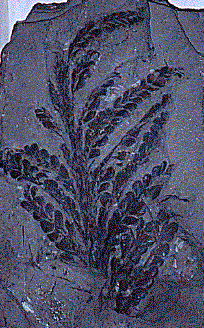







The Devonian seas were dominated by brachiopods, such as the spiriferids, and by tabulate and rugose corals, which built large bioherms, or reefs, in shallow waters. Encrusting red algae also contributed to reef building. In the Lower Devonian, ammonoids appeared, leaving us large limestone deposits from their shells. Bivalves, crinoid and blastoid echinoderms, graptolites, and trilobites were all present, though most groups of trilobites disappeared by the close of the Devonian.
The Devonian is also notable for the rapid diversification in fish. Benthic armored fish are common by the Early Devonian. These early fish are collectively called "ostracoderms", and include a number of different groups. By the Mid-Devonian, placoderms, the first jawed fish, appear. Many of these grew to large sizes and were fearsome predators. Of the greatest interest to us is the rise of the first sarcopterygiians, or the lobe-finned fish, which eventually produced the first tetrapods just before the end of the Devonian.

By the Devonian Period, life was well underway in its colonization of the land. Before this time, there is no organic accumulation in the soils, causing these soil deposits to be a reddish color. This is indicative of the underdeveloped landscape, probably colonized only by bacterial and algal mats.
By the start of the Devonian, however, early terrestrial vegetation had begun to spread. These plants did not have roots or leaves like the plants most common today, and many had no vascular tissue at all. They probably spread largely by vegetative growth, and did not grow much more than a few centimeters tall. These plants included the now extinct zosterophylls and trimerophytes. The early fauna living among these plants were primarily arthropods: mites, trigonotarbids, wingless insects, and myriapods, though these early faunas are not well known.
By the Late Devonian, lycophytes, sphenophytes, ferns, and progymnosperms had evolved. Most of these plants have true roots and leaves, and many are rather tall plants. The progymnosperm Archaeopteris, whose leaves are shown at right, was a large tree with true wood. In fact it is the oldest such tree known, and produced some of the world's first forests. By the end of the Devonian, the first seed plants had appeared. This rapid appearance of so many plant groups and growth forms has been called the "Devonian Explosion". Along with this diversification in terrestrial vegetation structure, came a diversification of the arthropods.
Devonian Times presents oodles of information about early forests and the first vertebrates on land. The information is based on findings at Red Hill, Pennsylvania, USA.
Read about the Devonian Mass Extinction at the Hooper Virtual Paleontology Museum.
Find out more about the Devonian paleontology and geology of North America at the Paleontology Portal.


